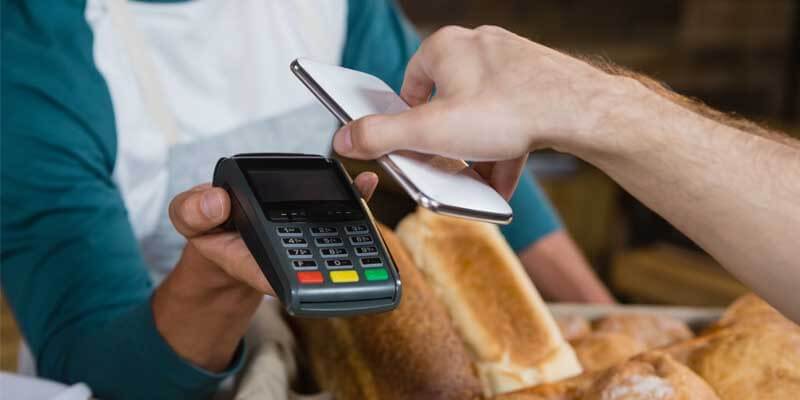
Let’s face it, accepting only cash or traditional payment methods these days is whack, which is why apps like this mobile btc wallet app are becoming more popular.. People hate the mess and the time constraint. Mobile payments like Apple, Samsung, and Android pay is what’s hot right now for customers and it’s not going anywhere anytime soon. If you have ever used mobile pay then you know it makes things easier. Our phones do a lot of other things for us, why not this? According to research done by the National Restaurant Association, 39 percent of all smartphone users said they would use a mobile payment option in restaurants if it were available. The research goes on to say that only 43 percent of quick-service restaurants and 31 percent of fast casual restaurants offered it in 2016. There is a percentage of restaurants who did plan to adopt in 2017, and it’s slowly gaining more and more momentum as it should be. Explore the past, present, and future of mobile payment solutions for restaurants below:
Before Mobile Payment Technology
Throughout history, people have always used some sort of payment system. It all started with the Barter system, and when the first restaurants started rolling out, people used cash. Then came along magnetic striped debit and credit cards. The funny thing is the checkout process stayed the same until now. Previous 10, 20, and even 50 years ago, people either paid at the counter or gave cash and more recently magnetic striped cards to the waiter and the waiter then processed it and gave them back a paper receipt. Now things aren’t as the once were. Payments can now be processed on the same device people make a phone call from, and they can be processed right at the table.
Present Reasons For Mobile Technology Changes
1. Online Ordering
Online ordering has enhanced the growth of mobile payment technology. People don’t just want to order their favorite dishes from their laptop, they want to order on the mobile device when they are on the go. There are currently many restaurants and franchises that have mobile apps where you can either set your payment method within the app or have your Apple Pay, Samsung Pay, or Android Pay completely integrated. Doesn’t that sound much easier than calling a restaurant on the phone, giving them your order and payment method over the phone?
2. Larger Tips for Waiters
One of the drivers behind waiters getting larger tips with mobile payment options is customer’s don’t feel like they are paying with real money. Customers also feel they had much quicker service because there is no waiting time between when the check was placed on the payment and when your receipt was brought back for payment.
Another way to look at is, how much easier is it to tap that 20% gratuity button on your phone than actually calculating the tip?
3. Turning Tables Faster
Paying the check can be somewhat daunting on both the customer and the staff member. When tables turn faster, your profits grow, your staff is happy, and so are your customers. The server never wants to pry and rush the guests. While the customer hates having to get the servers attention, tell them they are ready for the bill, and having to wait for the bill to arrive at the table. Any of these checkpoints in the checkout process can ruin a mealtime experience.
4. Customer Experience Improvement
Most people don’t carry cash anymore, and if they do it’s a very small amount. Whether it be quick service or fine dining, most customers don’t like a drawn out payment process. They prefer something quick because either they have already eaten their food and they are trying to leave, or they just got their food and they are ready to eat.
Receipt length is also a factor in the customer experience. Is a 2-foot long receipt or 4 copies really necessary? These days, people prefer to carry around less than they have to, and a pile of printed receipts is just really uncool.
5. More Customer Insight
We have all seen those detective movies where the detective asks a business for a receipt of a suspect and to only be let down to learn that the customer has paid cash. Cash is almost 100% untraceable, especially with a high volume of customers. Sure you can remember that weird guy who paid with cash, but if you were asked to remember all of the information for say 30 customers who paid cash on a certain day? With mobile payments, it makes things easier than ever to track customer information and purchase habits for your restaurant. Know in real time what the most purchased dish was of the day, last week, or last month. Real-time data can better benefit you in the ability to know and fix problems within your restaurant.
6. Better Customer Loyalty
Isn’t a huge volume of paper coupons and keeping up with a reward punch card annoying? As a customer or a restaurant, wouldn’t you like this automated? No mess and no worries about keeping up with the program. As a customer, wouldn’t you like your rewards already synced with your mobile number, payment method, or online account?
The Future of Mobile Payment Technology
The only drawback in the future of mobile payment solutions in the fine dining sector. There are some fine dining experts who would argue that it’s not a good idea to process a mobile payment at the table, and you wouldn’t want a waiter taking your phone away from the table either for payment processing. Mobile payment solutions may just be for the quick service and fast casual industries, but it’s too early to find out.

